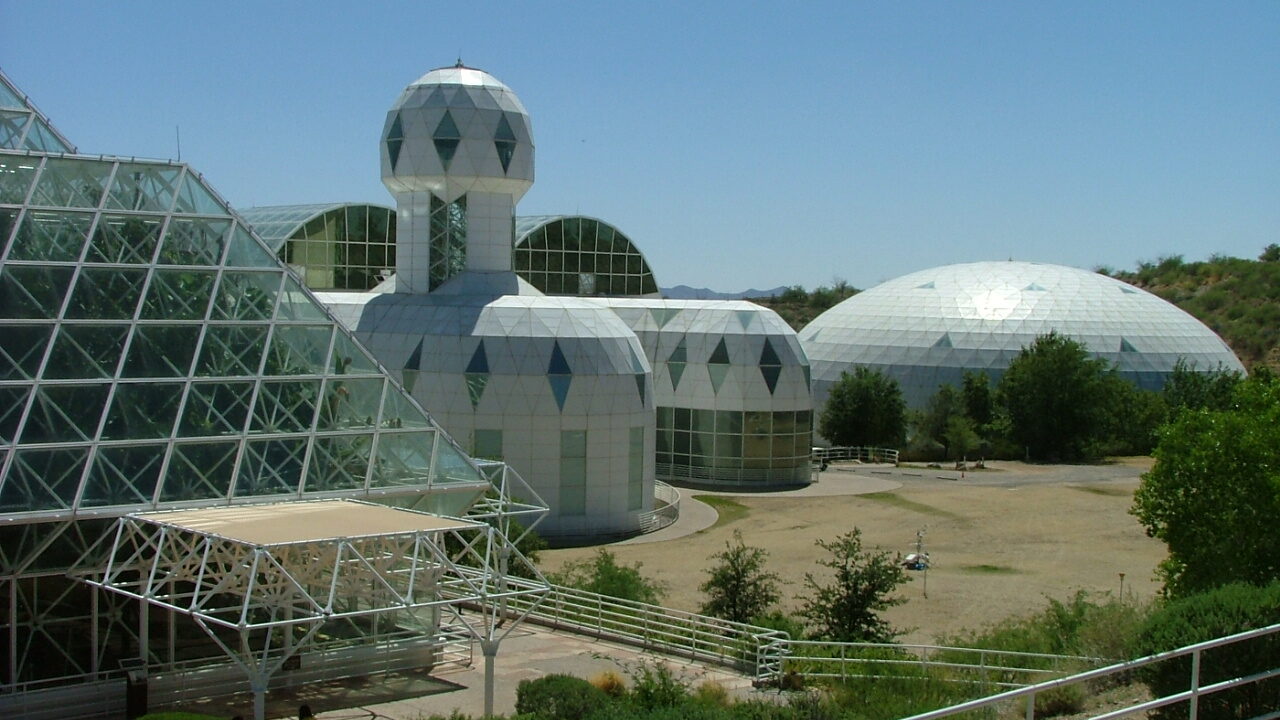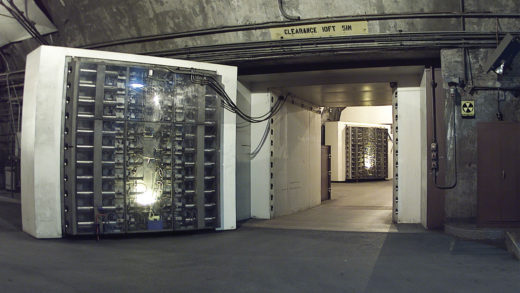A while ago I was watching The Expanse, which is a largely very well-done ‘hard’ science-fiction series, and one of the things that particularly stuck out to me is the portrayal of water and air. Water is accurately described as being a valuable commodity in the Belt and on Mars. Air, or rather the filters that keep the air breathable, are also portrayed as a key commodity. The high profile of these two key commodities made me start thinking about artificial biospheres, which also links back to my previous post about living underground.
The importance of water
Water is obviously essential for human, and indeed almost any, life, and not only that is also an excellent precursor for rocket fuel. Oxygen and hydrogen, in the form of cryogenically cooled liquid, are common rocket propellants, used by both the Space Shuttle and the Saturn V rockets that launched the Apollo missions amongst others. One of the best ways of obtaining oxygen and hydrogen is by the electrolysis of water. Now, in the setting of The Expanse it seems that the ships are mostly propelled by fusion drives. Being a theoretical concept exactly what the fuel for those would be is unknown, but deuterium/tritium or deuterium/helium-3 is probably most likely. As an isotope of hydrogen, the best source of deuterium is still water (water with one or two deuterium atoms instead of hydrogen is usually called heavy water), the oxygen would just be surplus in this case. As well as its possible role in rocket fuels oxygen is also of course required by people to breathe so in that sense water fulfils both the requirement for water itself, and for breathable air. Alongside life support on ships and for reactor fuel, water is also required in large volumes by Mars for their terraforming projects.
All around then we can see that water is going to be in high demand. Water is also heavy. It is certainly a lot less dense than steel or even aluminium, but whereas the hull of a spacecraft can be very thin, with water you need a big volume of it. This makes water expensive to transport, especially so for shipping off Earth because of Earth’s stronger gravity, unfortunate since Earth has plenty of water to go around – too much in fact since the views of Earth we see show clear effects of rising sea levels from the melting polar ice caps.
The water in the Belt, and for the Martian terraforming projects thus comes from water-rich asteroids and the moons of Jupiter and Saturn. Expensive shipping combined with high demand makes water very valuable. This is something that has been widely recognised by prospective asteroid mining companies and one of the most important components of a hypothetical space economy is expected to be extracting and supplying water.
Early in the series as we are introduced to the setting, we see that there is a water shortage on Ceres, which is somewhat ironic as Ceres was once one of the main water extraction locations but has been mined dry. Incidentally, this is one point where the setting is a little bit less believable if you know a few things about Solar system bodies. There is some uncertainty, but Ceres is probably about 25% water by mass. With a total mass of 1021 kg, that means Ceres has about 2.5×1020 kg of water. Now, most likely not all of that would be economical to extract, but if we assume that around 1020 kg can be extracted economically that is roughly 10% the mass of Earth’s oceans. That is an enormous amount of water, enough to cover Mars to a depth of 1 km if spread evenly over the surface and certainly more than enough to fill the Borealis basin that covers the northern hemisphere and give Mars a nice ocean of its own. Basically, if you’ve extracted all of the water from Ceres then the terraforming of Mars is almost certainly done.
On the other hand, moving that much material around (at least if you are hauling it in ships) is utterly ridiculous. Some of the biggest ships operating on Earth’s oceans today are oil tankers, the largest of which are ultra-large crude carriers that can carry up to half a million tonnes of oil. The ice hauler Canterbury that we see in the series is actually even bigger, at around 1000 m long and 250 m wide. Most of the structure seems to be open lattice work for holding ice chunks, so the Canterbury might be able to hold 50 million tonnes of ice. That is still tiny compared to the ice content of Ceres though. Even moving less than 1% of Ceres’ ice would need 100 million trips by ships like the Canterbury. That would take centuries even with tens of thousands of similar ships.
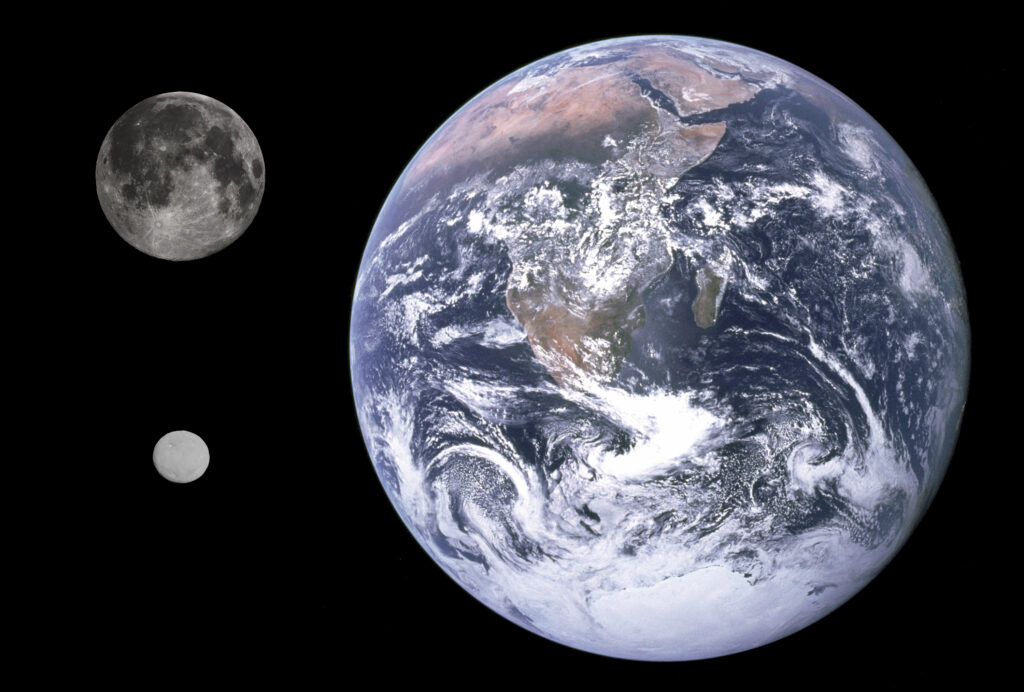
Water cycles
Setting aside that quibble with the realism, let’s move on to thinking about the life support systems of a spacecraft or space station.
Although water is heavy and expensive to move around it is important to bear in mind that water for human everyday usage isn’t actually consumed. That is, while the water may be ‘contaminated’ after use it isn’t destroyed, all of the water that enters a human body also leaves it, as urine, sweat or water vapour in our breath. The same goes for water that is used for washing clothes or fed to plants or other animals. The only space-borne use for water that results in its destruction is making rocket fuel, and if we are just interested in extracting the deuterium for fusion reactors we would only be taking out a small fraction (on Earth the ratio of deuterium to hydrogen is about 1 to 6400).
As a result, and especially given that water is expensive to move around, the water on a spacecraft or space station would be recycled as much as possible. Some people might find the idea of drinking water that has been recycled from urine distasteful, but the point about water not being destroyed, only processed through the bodies of creatures applies on Earth too. As a rough estimate humans drink about a 1 litre of water a day on average, and humans currently constitute about 1/3 of all land vertebrate biomass1 (which personally I find a terrifying statistic). There are 7 billion humans, so if other vertebrates use water at the same rate proportional to their size that comes to about 21 billion litres a day. Compare that with the total volume of water on Earth (1.4×1021 kg) and assume that the total biomass of land animals hasn’t changed all that much and you find that it would take about 180 million years for all of the water on Earth to have passed through some sort of vertebrate land animal. In other words, a non-zero fraction of the water you are drinking today was once dinosaur urine. Add in fish, invertebrates and plants and the cycling time would be much faster, but they probably use water at different rates so it would be more of a guess. Modern sewage treatment systems can produce water that is just as safe to drink as the water that comes out of your kitchen sink. Indeed never mind dinosaurs, if you live in a city like New Orleans, in the lower reaches of a long river, some of the water you use will already have been through the systems of cities upstream (in the case of New Orleans, places like Memphis, St. Louis and Minneapolis).
The point of all this is that a large spacecraft or space station would only need to add new water to its life support system to account for an increasing population (or increased farming, etc) and to make up for small loses like water vapour lost from an airlock or a leaking pipe. In fact, you can combine your oxygen-producing hydroponics into your water filtration system too. Water that isn’t quite up to human drinking standards is still fine for your plants, and the water they transpire through their leaves is essentially pure, so when you then extract it from the air with a dehumidifier it needs very little filtration.
If Ceres has a sensibly designed water system it would thus only be having a water shortage if the population had increased rapidly, or if the system hasn’t been maintained properly, leading to leaks. Given what we see in the show either or both of those might be the case, and given that it should be much easier to fix it would be all the more frustrating for the Belters.
I should note that I specified a large spacecraft or space station since a small one might not have the space for a complete water purification system. A small spacecraft would probably store wastewater on board until it docks at larger space station where it can off-load the wastewater into the station systems and take on fresh water – for a fee, of course. For comparison the International Space Station has a water recycling system that recovers around 70% of the water used by the crew for re-use.
Keeping the air breathable
In contrast to what I said about water just being cycled through people, oxygen in the air is actually converted in the body into carbon dioxide, so if you leave a person, or any other animal, in a sealed room the oxygen level will decrease and the carbon dioxide level will increase until eventually they asphyxiate. Of the two it is the rising carbon dioxide that is slightly more important.
The atmosphere of Earth is 21% oxygen, but a person can survive quite happily with 16-17% oxygen. That is actually the percentage in air you breathe out, and thus what you are blowing into the lungs of someone that you are doing mouth-to-mouth resuscitation on. If you are suddenly introduced to an atmosphere with less oxygen than that you would start to get a headache and feel lethargic, but you can acclimate to levels down to about 10%2. This is exactly the same as going to high altitudes. At a high altitude although the air is still 21% oxygen the pressure is lower and so the amount of oxygen available to your body is lower. At about 2000m the pressure is about 80 kPa, compared with 100 kPa at sea level, so the partial pressure of oxygen is about 17 kPa, the same as a 17% oxygen atmosphere at sea level. At about 5500m the atmospheric pressure is only half that at sea level and that is why people climbing high mountains generally use supplemental oxygen.

For every molecule of oxygen you absorb, you release a molecule of carbon dioxide, so the decrease of oxygen and increase of carbon dioxide happen essentially in tandem. The air on Earth today is about 0.041% carbon dioxide (increased from 0.028% before the industrial revolution). Concentrations up to 1% don’t have any noticeable effect and humans can survive in concentrations up to about 4-5% with only modest effects. If the concentration goes above 6.5-7% however you will rapidly start getting confused, have trouble breathing, and before long, asphyxiate, even if you have more than enough oxygen. As the astronauts on Apollo 13 discovered, scrubbing the carbon dioxide out of the air is thus very important.
This again is something we see portrayed in The Expanse, with unscrupulous merchants profiting off the sale of shoddy air scrubbers that can potentially result in the death of the unfortunate Belters that buy them.
Closing the cycle
In the case of both water and oxygen/carbon dioxide what we thus want is a closed, self-regulating system that produces drinkable water at the same rate it is used and maintains stable levels of oxygen and carbon dioxide. To that we can also add things like food production and waste disposal. The biosphere of Earth is exactly such a closed, self-regulating system. Dirty water is processed by a variety of different organisms in rivers, lakes and oceans. Water then evaporates from those surface bodies and falls again as clean rain, closing the cycle. Likewise, oxygen consumption and carbon dioxide production by respiration is balanced by oxygen production and carbon dioxide consumption in photosynthesis. Solid biological waste is processed by a wide range of organisms and some will serve as fertiliser for photosynthetic plants that lie at the base of the food web.
What we want to do then on our large space station is to create an artificial biosphere that can maintain a habitable environment. This biosphere does not need to be as complex as that of Earth. Indeed, given the much smaller space it can’t be. Given that the biosphere is being established and maintained by humans a certain degree of simplicity is helpful and one can imagine developing something like a minimal sustainable biosphere. Such a minimal biosphere might have a few species of bacteria for processing human waste and a few species of plants to provide oxygen and food for the humans. In reality there would be somewhat more species of plants and bacteria, both to ensure a balanced diet for the humans and ensure all of the waste products are broken down, and to provide a degree of resilience – something we will return to later.
Space requirements
For now, let’s think about how much space we need for our artificial biosphere. In my previous post I discussed food production and estimated that a hydroponics unit about the size of a shipping container would provide enough food to support 4 people. Unlike the underground vaults here we are trying to construct a completely closed system, so we want to think more carefully about the water and air requirements.
First, we need to know how much water and oxygen we need for each person on the station. Fortunately, NASA has us covered here, estimating that a typical crew member needs 0.84 kg of oxygen per day along with 2.38 kg of water for drinking and food preparation3. Rather gratifyingly, that NASA document also suggests that my estimate of 1.5-2 kg/day of food was about right. Alongside water for drinking and food preparation people also need water for hygiene purposes – washing their hands, showering, washing clothes, etc. NASA estimates this at 10-25 kg/day per person, outweighing the mass of water for drinking and food preparation by a factor of 4-10. Most of the difference between the upper and lower bound is water for washing clothing. Another study, based on the Russian BIOS-3 experiment from the 1970s comes to similar conclusions, suggesting 1.3 kg/day of oxygen along with about 11 kg/day of water for both drinking/food preparation and hygiene5 (the BIOS-3 crew didn’t need to worry about washing their clothes).
That 10-25 kg/day does not tell us the total amount of water that we need for each person though, since we also need to know long it takes water to pass through the recycling system. For sewage treatment plants on Earth it seems that the typical water residence time is about 13 days on average, albeit with quite a wide range and the upper end of residence times, around 30 days, might be more representative of what needs to be a very thorough treatment system, including passage through the hydroponics system. That means then that we would need between 300 and 750 kg of water per person on the station. That is a lot of water, substantially more than the mass of the human crew.
Another NASA document on regenerative life support systems (i.e. artificial biospheres), suggests that oxygen generation might not need any increase in plant life over what we already need to feed the crew6. At normal Earth carbon dioxide levels 10 square metres of wheat can cycle around 1 kg/day of carbon dioxide and that can be increased by a factor of up to around 6 by increasing the concentration of carbon dioxide, which would be easy enough to do in our closed growing system. Doing so would of course require that we have something that scrubs carbon dioxide from the atmosphere of the human habitation section and pipes it into the hydroponics section, but that is probably wise in any case. We will want to have a buffer for both oxygen and carbon dioxide so that if there is an excess of production of either one it doesn’t immediately cause problems in the other part of the system.
Overall, it seems like a reasonable estimate would be to supplement our hydroponics container with another one that houses the waste processing. In that case to support a 4-person crew our life support system/artificial biosphere would probably need to occupy about 150 cubic metres and contain 2-3 tonnes of water. Obviously, this is a minimum and it could easily be larger than this, for example if we distribute some plants in less space efficient configurations in public areas to help crew morale. It would also be expanded if the crew have some livestock to provide protein.
System fragility
An important consideration that I’ve hinted at a couple of times is the fragility or robustness of the system and its ability to react to changes. For example, if we have a crew of 4 and a biosphere adapted to support 4 people, adding a 5th person and increasing the load on the system by 25% is going to put a big strain on the system. Adapting it would require increasing the numbers of oxygen producing plants and those will of course take time to grow. Similarly, if that 5th person then left again the biosphere would be producing too much oxygen and again would need time to adapt. This is why it is important to have buffers so that the arrival of that 5th person doesn’t immediately result in a depletion of the oxygen in the system but instead draws from oxygen reserves until the system can adapt. Clearly the larger the crew and biosphere the more readily it is capable of buffering changes naturally without the need to holding tanks or some other type of technological buffering solution. Adding an extra person to a crew of 1000 would result in such a small change that the system would easily be able to adapt.
Alongside changes in the load on the biosphere from the changes in the number of crew members we also need to consider the possibility of something going wrong. In ecology there is a concept of keystone species, species that are profoundly important to the environment and if they are removed will result in a dramatic alteration of the ecosystem. In our highly simplified artificial biosphere effectively every species is a keystone species. If a disease wipes out a crop species, or a chemical imbalance kills off one of the species of waste processing bacteria, that has potentially dire consequences for the biosphere. Since this biosphere is being maintained in an what is otherwise an extremely inhospitable environment (the vacuum of space) it is also vulnerable to mechanical failures – pumps that circulate water and atmosphere breaking down, hull breaches, etc.
What these issues lead to is the possibility of cascade failure, that is a failure in one part of the biosphere can propagate throughout the system and result in failures happening elsewhere until the entire system collapses. Exactly this situation arises on Ganymede in Season 2 of The Expanse as a result of collateral war damage. Once a cascading failure has propagated far enough it can be almost impossible to prevent further collapse, making them especially dangerous.
To make the artificial biosphere of a ship or space station more resilient against the possibility of cascade failure we need to increase redundancy in the system. For the mechanical parts this would mean things like adding backup pumps in case one breaks down. For the biological elements it means adding more species that fulfil similar roles, i.e. increase the biodiversity, so that is less likely that some disease or problem will wipe out an entire component of the biosphere. It was partly for this reason that Biosphere 2 tried to pack as much biodiversity into the project as they could with multiple sections containing different biomes.
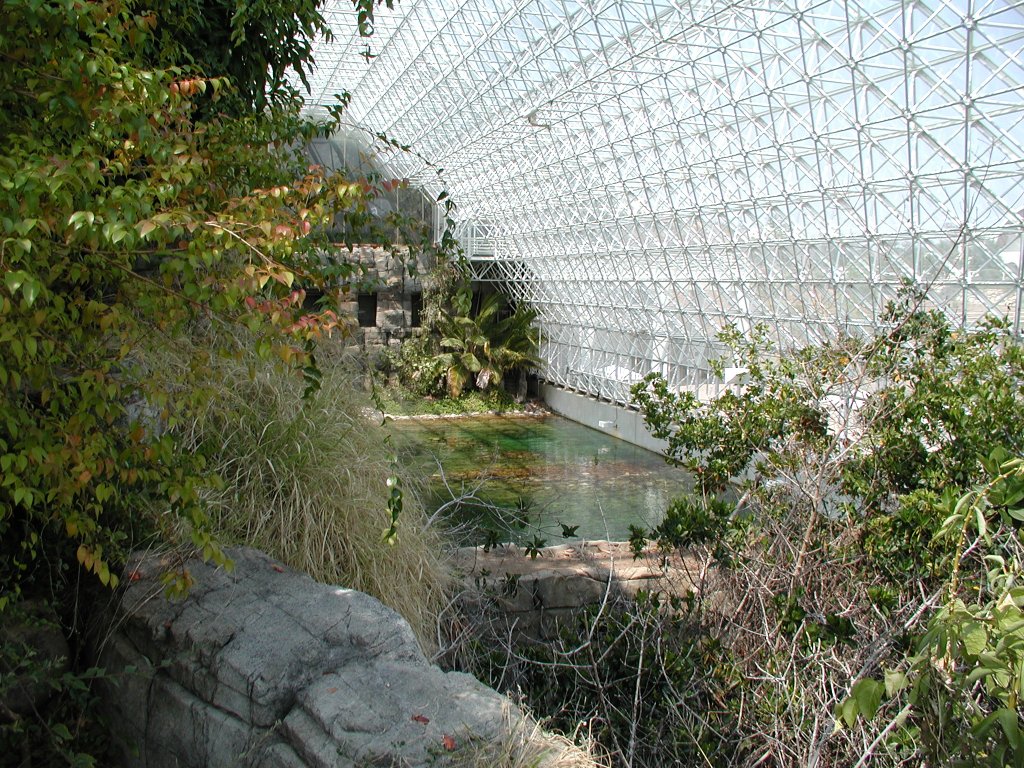
Thornscrub area 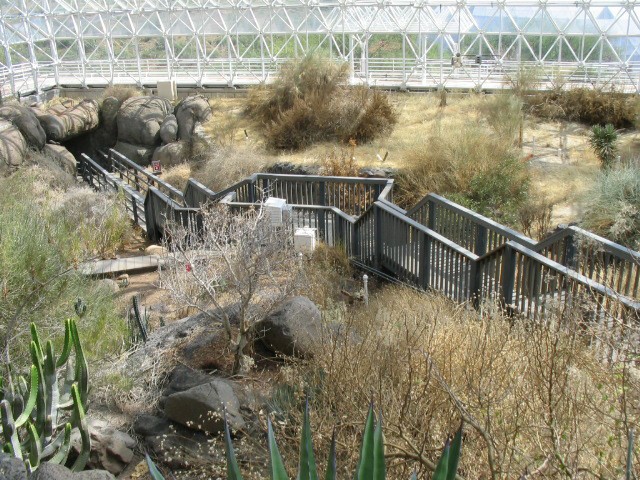
Fog desert biome 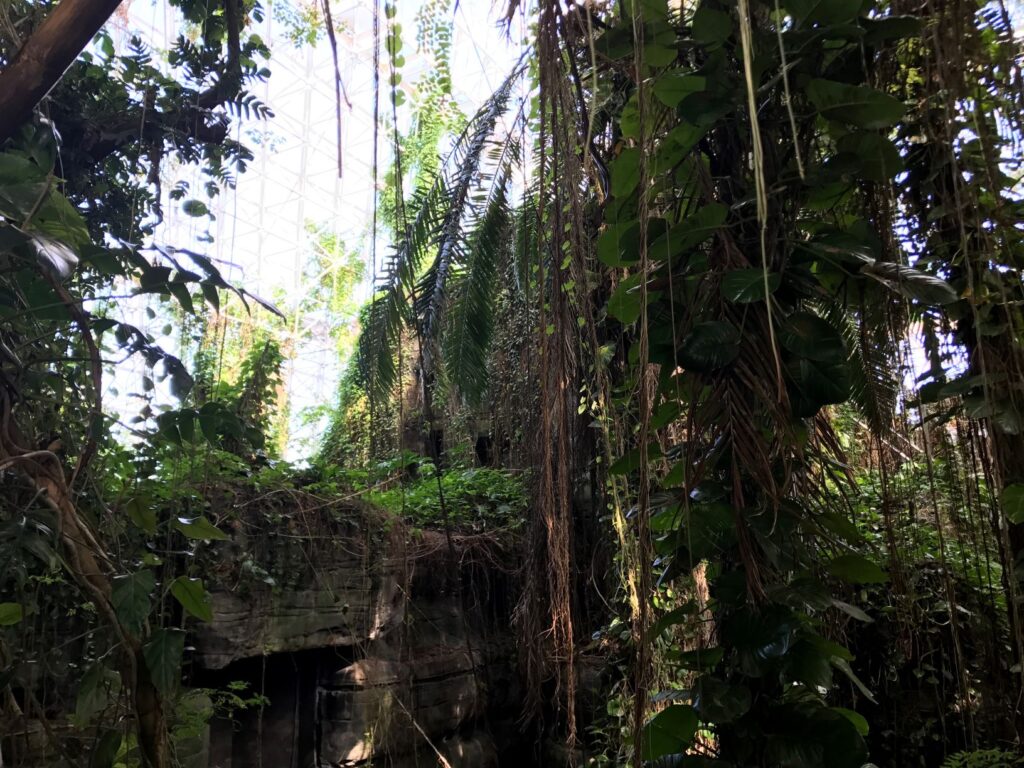
Rainforest biome
Conclusions
Probably the most important take away is that when it comes to artificial biospheres, bigger is generally better. The larger the biosphere the more diverse and resilient it can be. For a small ship maintaining a full artificial biosphere may not be worth the trouble and the space it would take up, with it instead making more sense to rely on mechanical system for partial recycling and making up the rest with periodic stops at larger space stations to replenish supplies. I don’t remember it being specified explicitly in The Expanse, but I imagine that the green plants we see in various parts of the Rocinante are not intended to provide a completely closed system but rather just to give a slight boost to the efficiency of the recycling systems and thus the range of the ship. That, and the other important role green plants can play that I haven’t mentioned is to improve morale. People generally like seeing plants, presumably because we instinctively associate them with hospitable locations and food, and so have greenery around can provide a boost to morale. Incidentally that also means that yes, your desk plant does have a purpose!
References
- Bar-On Y.M., Phillips R., Milo R., PNAS, 2018, https://www.pnas.org/content/115/25/6506
- https://msis.jsc.nasa.gov/sections/section05.htm#_5.1_ATMOSPHERE
- https://ntrs.nasa.gov/citations/20040012725
- https://www.thewastewaterblog.com/single-post/2016/12/16/Mean-Cell-Residence-Time
- Salisbury F.B., Gitelson J.I., Lisovsky G.M., 1997, http://bioscience.oxfordjournals.org/content/47/9/575.full.pdf
- https://ntrs.nasa.gov/citations/19910015430
